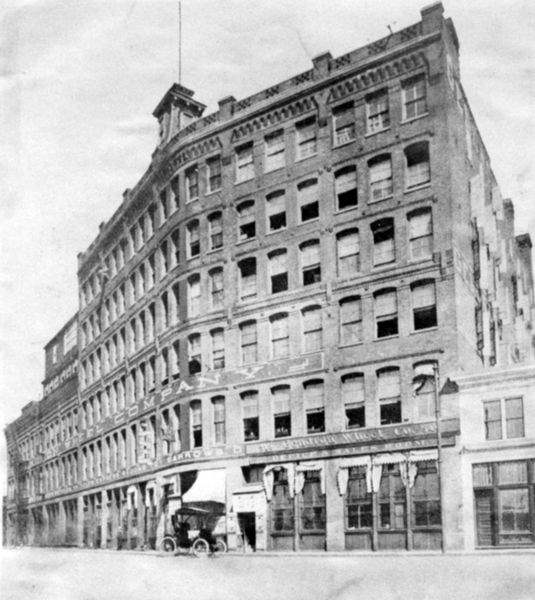
Better wheel invented in Toledo blazed path toward autos
5/20/2008
Gendron s factory, parts of which were six stories tall, occupied most of a block in downtown Toledo.
NOT BLADE PHOTO
The wheel was invented thousands of years before Peter Gendron was born in 1844. But the Toledo industrialist invented a better wheel, with wire spokes.
He went on to found several companies, including Gendron Wheel Co., which became known worldwide for its baby carriages, bicycles, and pedal cars.
And he was among a number of industrialists who, around the turn of the 20th century, helped create the critical mass of parts manufacturing, skilled workers, and dealership networks that allowed the early automotive industry to flourish. Toledo was a great beneficiary of that trend, becoming an early automotive center and later a major maker of auto parts.

A new book, Gendron 1872-2007: Pedal Cars, Bicycles & Victorian Carriages, chronicles the first 135 years of a company that still makes products under the Gendron name.
The book is a testament to the power of inventiveness and entrepreneurship and also the need for companies to diversify to survive. The current Gendron Inc., based in Bryan, bears little resemblance to the one formed by Mr. Gendron. It now makes electric wheelchairs, hospital beds, stretchers, and other medical equipment.
The cover of the book by Frederic W. Strobel II, retired chairman and chief executive of Gendron, is a collage of some early products that made the Gendron name famous: a baby carriage, a toy wagon, kiddie cars, a tricycle, and a battery-powered toy car.
Mr. Strobel, who lives in Montpelier, Ohio, tells a story that is familiar to many Toledo-area residents, but he also collected hundreds of photographs and other company memorabilia at antique malls, toy shows, trade publications, and the Internet.

Gendron s factory, parts of which were six stories tall, occupied most of a block in downtown Toledo.
His story begins with the birth of Pierre Gendron (later known as Peter) in St. Ours, Quebec, Canada, Feb. 23, 1844. He was one of 10 children in a French-Canadian family, and his father, Jean-Baptiste Gendron, was a wagon maker.
In 1865, at the age of 21, Peter Gendron immigrated to Toledo with his new wife, Delima, and became a pattern maker for Toledo Novelty Works. By 1870, Mr. Gendron was a co-founder of a small firm on Summit Street that made children's carriages, but it soon failed, and he went to work in Detroit for a year or so.
He invented a new type of lightweight, wire-spoked wheel in 1872, soon returned to Toledo, and in 1873 filed for patents on the wheel and also a lighter-weight carriage.
His name would eventually appear on 40 patents - for wheels, welding machinery, assembly equipment, and a friction-reducing ball bearing for bicycles.
Mr. Gendron's second attempt at business, the Gendron Iron Wheel and Carriage Co., also failed for lack of capital, so he moved his operation into his home on Walnut Street (now a historic site).
But by 1880 he was ready to try again and was a founder of the Gendron Iron Wheel Co.
By the 1890s, the firm had expanded greatly, with the addition of a plant in Toronto, and changed its name to the Gendron Wheel Co.
And by 1910 it claimed to be the biggest manufacturer of bicycles in Toledo (a major center for bicycles then) and the world's largest maker of children's wheeled vehicles.
It occupied most of the downtown Toledo block bounded by Orange, St. Clair, Jackson, and Superior streets.
The building, parts of which were six stories high, housed hundreds of employees.
Mr. Gendron died in 1910, at the age of 66, but the business continued under a succession of owners and managers.
In 1927 it merged into American-National Co. and in the 1930s it expanded into wheelchairs and hospital equipment. When World War II began, Gendron concentrated on hospital equipment, and the pedal-car era ended.
Headquarters moved to Perrysburg in 1941 and to Archbold in 1959. In 1964, Gendron was bought by Howe Sound Co. (Howmet), of New York.
Since then, it has had several names - including Gendron-Diemer Inc. and, most recently, Gendron Inc. - and moved its offices to Bryan late last year. The assembly plant is in Pioneer, Ohio.
The book was published by Timeless Collectibles by Gendron, Mr. Strobel's Montpelier firm, and is distributed by Pedal Car Books, of Fraser, Mich. (www.pedalcarbooks.com).